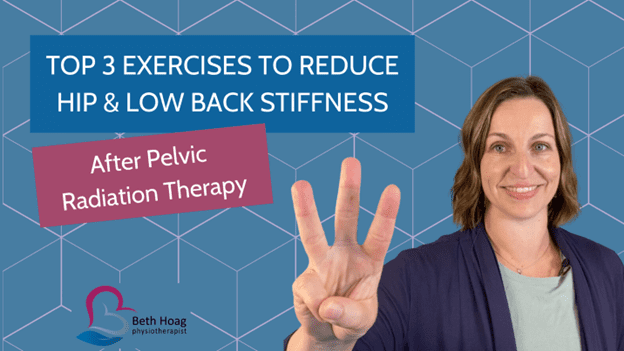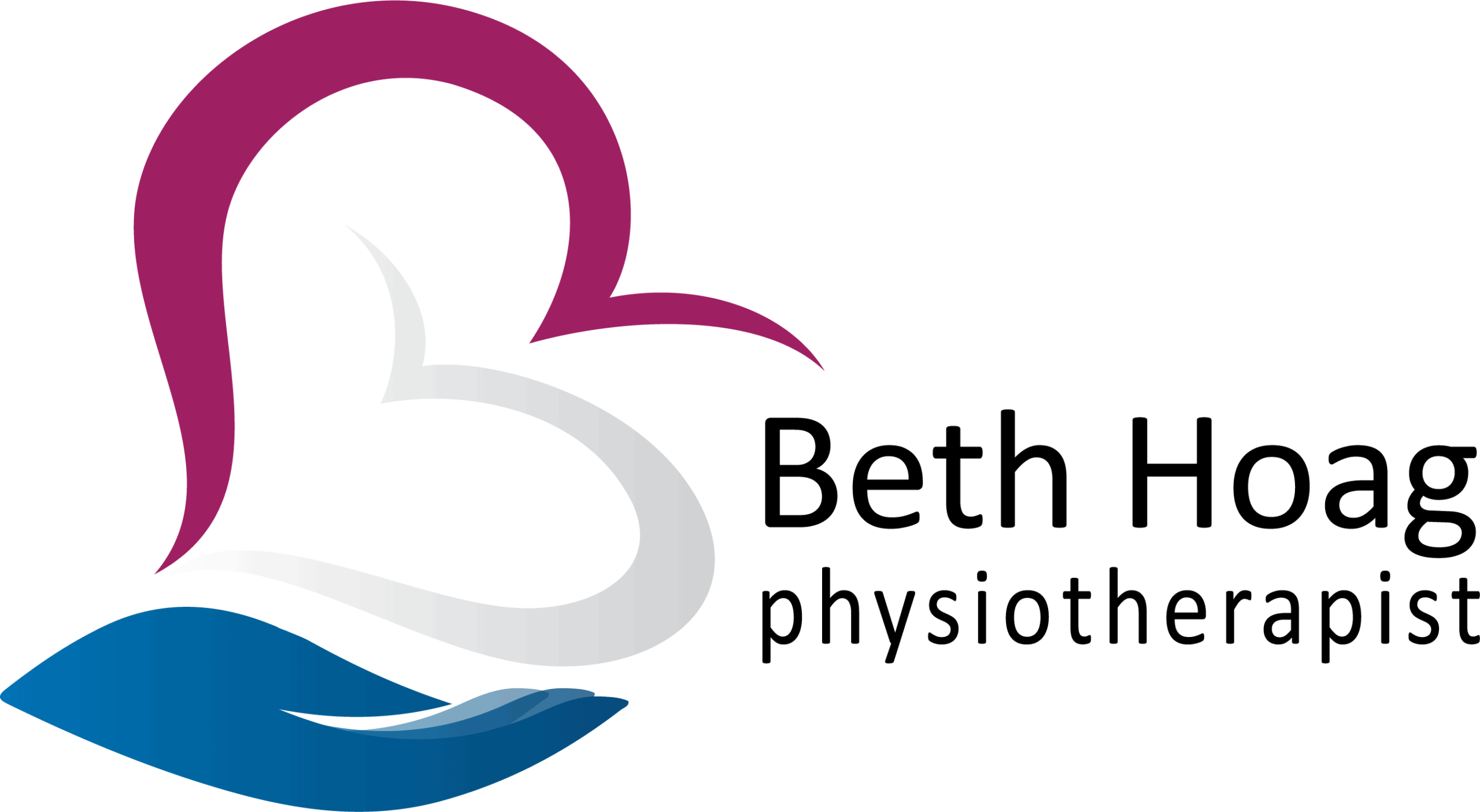Hip and low back stiffness is a common long-term side effect of pelvic radiation therapy, especially external beam radiation. This stiffness typically comes on gradually, often months after pelvic radiation therapy is complete. Over time this can lead to pain and even difficulty with simple tasks like crossing your legs, sitting on the ground or in low seats and putting on your shoes in socks.
Many people have no idea that these symptoms can be a long-term side effect of pelvic radiation. For those that do make the connection, many are told that “this is their new normal”, leaving them feeling disempowered and alone.
In this blog, we’re going to give you actionable things that you can do immediately to shift this “new normal” and start feeling better. Though we can’t fully undo this stiffness, we certainly can improve things.
Why Does Stiffness in the Hip and Low Back Happen?
We know that tissue healing after radiation therapy continues for months if not years after radiation is complete. Long after the skin and tissue irritation is gone, tissue healing continues. This is the part that nobody seems to be talking about!
Any tissues that were in the radiation field can become progressively tighter and restricted over time; I often describe this as the “shrink-wrap effect.” In the case of pelvic radiation therapy, this can gradually pull on the hips and or low back over time.
If you’re interested in learning more about this long-term healing process after radiation therapy, I invite you to read my blog about radiation fibrosis. (Note: This blog is specific to breast/chest radiation, but the information about tissue healing is the same for any body part.)
3 Ways You Can Reduce Stiffness in Your Hips and Low Back
1. Movement snacks
Our bodies are really designed for movement, but the reality is we all spend a lot of our day sitting. Whether you’re home recovering from your pelvic cancer treatment or back at work in a desk job, a lot of us spend too much time sitting. This lack of activity can make hip & low back stiffness feel worse.
I know it sounds counterintuitive to be encouraged to move more when it’s tough to move, but it’s a vicious cycle.
When we feel stiff and uncomfortable, we tend to move less, but when we move less we tend to feel more stiff and uncomfortable. So, we need to find a way to break this cycle, and movement snacks are a great way to do this!
Small “bite-sized” movement breaks, multiple times throughout the day, can make a huge difference. Once every 30 minutes to 1 hour, get up and do some simple movements for the hip and the low back for 1-2 minutes:
- Marching on the spot (sitting or standing)
- Stand up and sit down in the chair multiple times
- Go get a drink of water or cup of coffee
- A walk to the bathroom
These things don’t need to be complicated, but they just need to happen frequently. Helpful reminders (so you don’t forget) can include setting an alarm on your phone or computer or sticking post-it notes in areas where you will frequently see them (so they remind you to get up and move.)

2. Daily Purposeful Exercise
Moving more is important, but it’s not the same as purposeful exercise (i.e. where we’re setting aside time to get our heart rate up and/or get stronger.) We ALL need to be making purposeful exercise a priority in our lives.
We should all be aiming to reach a minimum of 150 minutes a week of moderate-intensity cardiovascular exercise in our lives. There are so many reasons why we need to make purposeful exercise a priority in our lives, but it’s beyond the scope of this blog to explore this in detail. In the case of hip and low back stiffness, purposeful exercise is going to help the low back and the hips feel better. I know this can be difficult, but the key is that some purposeful exercise is better than nothing.
Here are a few tips to get you started:
- Choose something that you enjoy!
- Find an “exercise buddy”
- Schedule it into your week (like you would any other appointment)
- Join a class
- Pace yourself: Start low intensity & progress slowly
- Consult a cancer rehab physio to help get you started
3. Targeted Stretching for the Hip and Low Back
Though there is no one “magic stretch” that will make all that stiffness melt away, there are some common movements that I share with my clients on a regular basis.
Regardless of the stretches you choose (you may have other ones you prefer):
- HOLD each stretch for 1-2 minutes
- Repeat them 1-2x/day at the beginning.
- Once you become more flexible, 1-2x/week may be enough
A few more stretching tips:
- Do your stretching after you’ve done some purposeful movement or exercise. This gives a chance for your muscles to warm up and it makes your stretching more effective.
- Do NOT force your stretches. You should feel pulling, but never an increase of pain during or afterwards.
- Take deep breaths and really invite your body to “melt” and/or “create space” while you breathe.
3 Hip and Low Back Stretches After Pelvic Radiation Therapy
1. Window Wipers
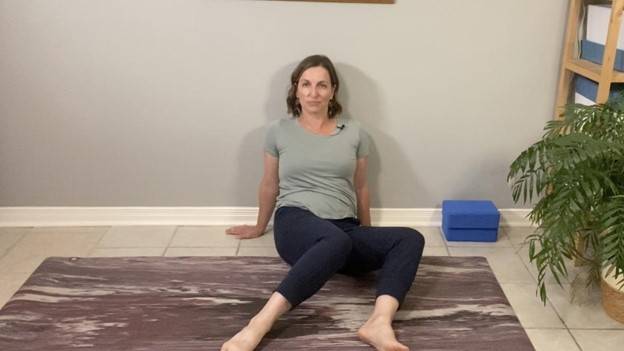
2. V-Sit (Inner thigh stretch)
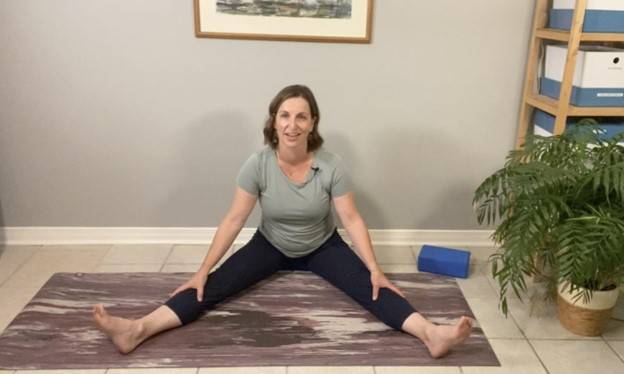
3. Figure 4 (Buttock stretch)
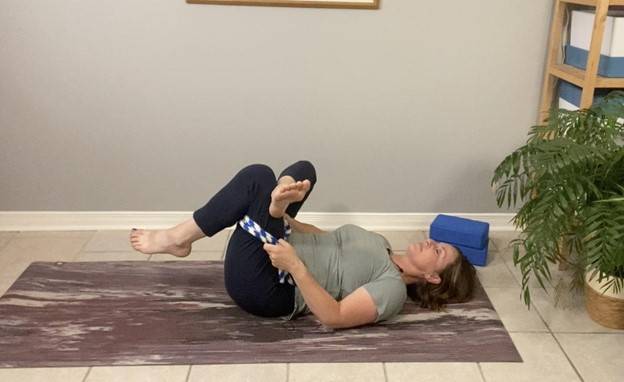

Key Takeaways: People who have undergone pelvic radiation therapy for cancer treatment may develop progressive stiffness and pain in the hip and low back months after treatment is complete.
- To improve this, Beth Hoag, Physiotherapist recommends:
- Doing “movement snacks” – short, frequent bouts of movement throughout the day to keep joints limber.
- Working towards engaging in 150 minutes per week of moderate-intensity exercise to improve mobility and overall health.
- Performing specific stretches for the hip and low back, holding for 1-2 minutes and repeating 1-2 times per day.
Disclaimer – These blogs are for general information purposes only. Medical information changes daily, so information contained within these blogs may become outdated over time. In addition, please be aware that the information contained in these blogs is not intended as a substitute for medical advice or treatment and you should always consult a licensed health care professional for advice specific to your treatment or condition. Any reliance you place on this information is therefore strictly at your own risk.

